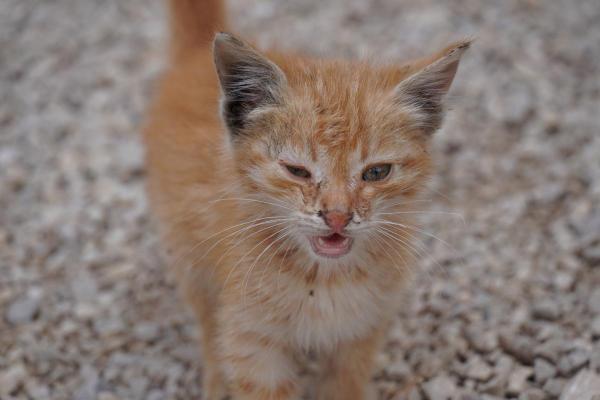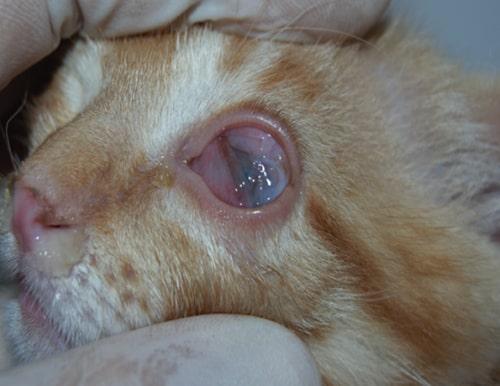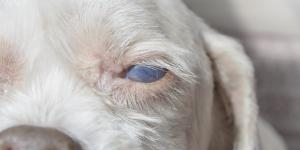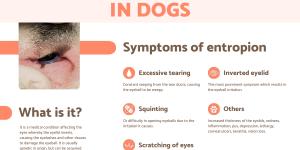Symblepharon in Cats - Causes and Treatment



See files for Cats
Symblepharon in cats is an ocular condition whereby the conjunctiva of the eyelid attach the the outer conjunctiva of the eyeball. These are known as the palpebral and bulbar conjunctiva, respectively. In can occur in one or both eyes, resulting in various symptoms such as discomfort and inflammation. Moreover, it affects the cat's ability to see. It is often accompanied by other lesions or damage to the eye of the cat. There are various causes, both pathological and traumatic in origin. It is particularly common among young cats as a complication of conjunctivitis, especially if they are affected by the Felid alphaherpesvirus 1 (FeHV-1).
At AnimalWised, we look more closely at the causes and treatment of symblepharon in cats. We also provide photos of the condition so you can see what its symptoms may look like if it affects your feline.
What is the symblepharon in cats?
Symblepharon in cats is not a disease in itself, but a symptom or medical condition which results from disease or other health problems. It consists of the formation of adhesions between the palpebral conjunctiva and the bulbar conjunctiva. Essentially, the eyelid becomes attached to the eyeball. It can also affect the third eyelid and the cornea. This causes alterations in the animal's vision and ocular health, in turn decreasing their quality of life.
This eye problem in cats is usually bilateral, meaning it affects both eyes. Generally speaking, one eye is usually more affected than the other. In addition, it is a common problem in kittens under 5 months of age, especially in those that have been picked rescued from outside.
Causes of symblepharon in cats
Since symblepharon in cats is a symptom, it is caused by underlying diseases. The exact cause which results in this symptom is not always known. One of the most common diseases which causes adhesion of the conjunctiva is conjunctivitis. This is a disease which occurs most frequently in young cats which have suffered a viral infection, such as feline rhinotracheitis caused by the Felid alphaherpesvirus 1 (FeHV-1). This is also known as feline influenza.
Feline rhinotracheitis affects the upper respiratory tract of the cat, causing both nasal and ocular symptoms. Many kittens are infected before their eyes have even opened due to infection of the mother. The infection is passed on through the mother's tears, saliva and fomites.
The virus is characterized by its ability to remain latent in the host that has overcome the infection. It can later be reactivated under conditions of stress or immunosuppression. Pregnancy and subsequent lactation are examples of such stressful periods, meaning the reactivated virus can easily transmit to her vulnerable offspring.
It is estimated that 95% of the world's cat population has had contact with this virus, either through infection or through the trivalent vaccine. 80% of this 95% of cats have the latent virus in their trigeminal ganglion, meaning it can reactivate the infection under conditions of stress or immunosuppression.
Other causes of symblepharon in cats include other types of infection, chemical agitation, physical trauma or inflammatory diseases. Although it is uncommon, it is possible that congenital conditions can affect the ocular region and influence the development of symblepharon. Autoimmune diseases can also have it as a symptom or it can trigger a reactivation of the herpesvirus.
Discover more about the causes, symptoms and treatment of feline rhinotracheitis in our related guide.

Symptoms of symblepharon in cats
It is quite common for a cat with symblepharon to also present epiphora. This consists of excessive tearing due to the adhesions blocking the drainage points of the tear ducts. In turn, this generates this excess tear production. Dry keratoconjunctivitis can also develop as a consequence of the blockage of the tear glands, causing them to progressively atrophy until they become inactive. This then triggers the symblepharon.
Other clinical symptoms that a cat with symblepharon may present include:
- Blepharitis
- Progression and adhesion of the nictitating membrane
- Keratitis
- Hyperemia or redness of the conjunctiva
- Corneal ulcers
- Blindness
- Inability to move the eye
- Chemosis
- Blepharospasm
As symblepharon is often caused by herpesvirus, symptoms such as apathy, fever, sneezing, mucopurulent nasal discharge and anorexia may also appear. Generally speaking, symptoms will depend on the underlying cause. The photo above shows a kitten with symblepharon.
Discover some of the most common eye diseases in cats with our related guide.

Diagnosis of symblepharon in cats
Symblepharon is rare in adult cats. It usually occurs in kittens and juvenile cats that have suffered from a conjunctival infection or similar form of conjunctivitis. The diagnosis is clinical, since the adhesion between the conjunctivae is clearly observed. In adult cats, instead of symblepharon after viral infection and conjunctivitis, recurrent hyperemia of the conjunctiva and dendritic ulcers usually occur.
Symblepharon is only one symptom of ocular disease in cats. Check out our article on why my cats eyes are red to see a more common clinical sign.
Treatment of symblepharon in cats
Since symblepharon usually appears as a consequence of viral conjunctivitis caused by Felid alphaherpesvirus 1 (FeHV-1), there is no specific treatment. Treatment is based on helping the cat recover from the viral infection with famciclovir being the antiviral that has demonstrated greatest efficacy and safety in studies. Doses of 90 mg/kg every 12 hours or 40 mg/kg every 8 hours. The first option involves administering the dose twice a day instead of three, so it is usually preferred.
In addition to antivirals, the use of broad-spectrum antibiotics is important to control secondary infections associated with the symblepharon. These are frequently caused by bacteria such as those from the Chlamydophila and Mycoplasma genera. Topical ocular treatments with antiviral eye drops or antibiotics are also commonly required.
In severe cases of symblepharon, surgery is the treatment of choice, especially if vision and eye mobility are compromised. It is relatively common for a corneal sequestrum in cats to develop after symblepharon. In these cases, there is a high probability this will reappear after surgery. In these cases, it is essential to carefully assess the risk-benefit of the operation for each individual cat.
Learn about how famciclovir for cats can help mediate viral infections with our related article.
How long does symblepharon last in cats?
Symblepharon usually persists for life. Although it may improve by treating the viral infection, the adhesion will always remain in some form. The only potential solution would be surgery. As we have mentioned, it is very likely to recur.
If you notice any of the above symptoms in your cat, do not hesitate and go to the veterinary centre as soon as possible to obtain a diagnosis. Discover more about various ocular diseases in cats and their clinical symptoms with our article on why my cat has brown eye discharge.
This article is purely informative. AnimalWised does not have the authority to prescribe any veterinary treatment or create a diagnosis. We invite you to take your pet to the veterinarian if they are suffering from any condition or pain.
If you want to read similar articles to Symblepharon in Cats - Causes and Treatment, we recommend you visit our Eye problems category.







